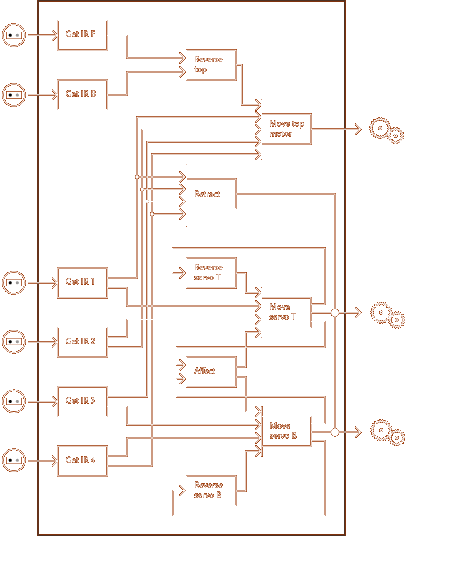|
overview
trundle
v1.2
anatomy
images
+
behavior
interaction
movement
trundle v1.1
anatomy
images
behavior
trundle v1.0
anatomy
images
|

Using social
language to describe the movement and interaction with Trundle, it can
be said that Trundle seeks attention, but is shy. It changes its mood
over time as a function of the amount of attention it receives. Mood
is communicated through posture and quality of movement. When Trundle
is first activated, its basic behavior is to seek out stimulus. This
is achieved through slowly scanning its lower four sensors across the
space. When it receives a stimulus through one of its sensors, it quickly
jerks away and moves down the track until it finds a spot free of stimuli.
In addition to a series of simple reflexes, the activity of Trundle
is dominated by a number of absolute actions. These are analogous to
the fixed action patterns found in many animals. For example, if all
four of Trundle's lower sensors are activated, it will quickly jerk
away and collapse into its neutral state. It sets all of its excitation
variables to neutral and slowly begins to expand the reach of its sensors,
starting at the top and moving its way to the bottom of the sculpture.
Trundle adapts its behavior over time by changing internal state variables
which affect how the sculpture senses and moves. For example, if Trundle
is constantly registering stimulus through its IR sensors, it can begin
to look for signals at a closer range. This will either cause people
to come closer or allow it to ignore large objects consistently in its
proximity. Trundle also has a concept of affect. Through continual interaction
with the sculpture, it may become excited and change the quality of
its movements to become increasingly rapid and short.
Trundle’s behavior
is implemented in C code as a series of finite state machines (FSM).
A map of its behavior architecture is displayed in figure 117. As a
result of the organic process of programming the architecture, changes
have been made to the original plan. It was found that the system was
made more flexible by abstracting the sensor data retrieval and conditioning
state machines from their initial couplings. For example, the original
Reverse_top FSM had the ability to read the IR data embedded within
it. By removing this from the machine, this data can now be used by
other FSMs as the architecture grows. The core FSMs are the Move machines.
Each of these starts one of the three motors in motion. Due to the nature
of the motors, these functions all differ. The Move_servo_T FSM, for
example, includes a number of state variables that move the motor a
specific distance represented in an increment variable every hundredth
of a second. In contrast, the Move_top_motor FSM simply stimulates its
motor with a constant value. Because this motor has no internal feedback
(as the servos do) it requires external sensors to be aware of its position
in the world. The Reverse_top machine continually monitors the location
of the sculpture and when it sees there is no room to move, it reverses
the direction. The Get_IR FSMs all share a similar form. All sensor
data is conditioned by a simple low pass filter created through weighted
averages.
|

